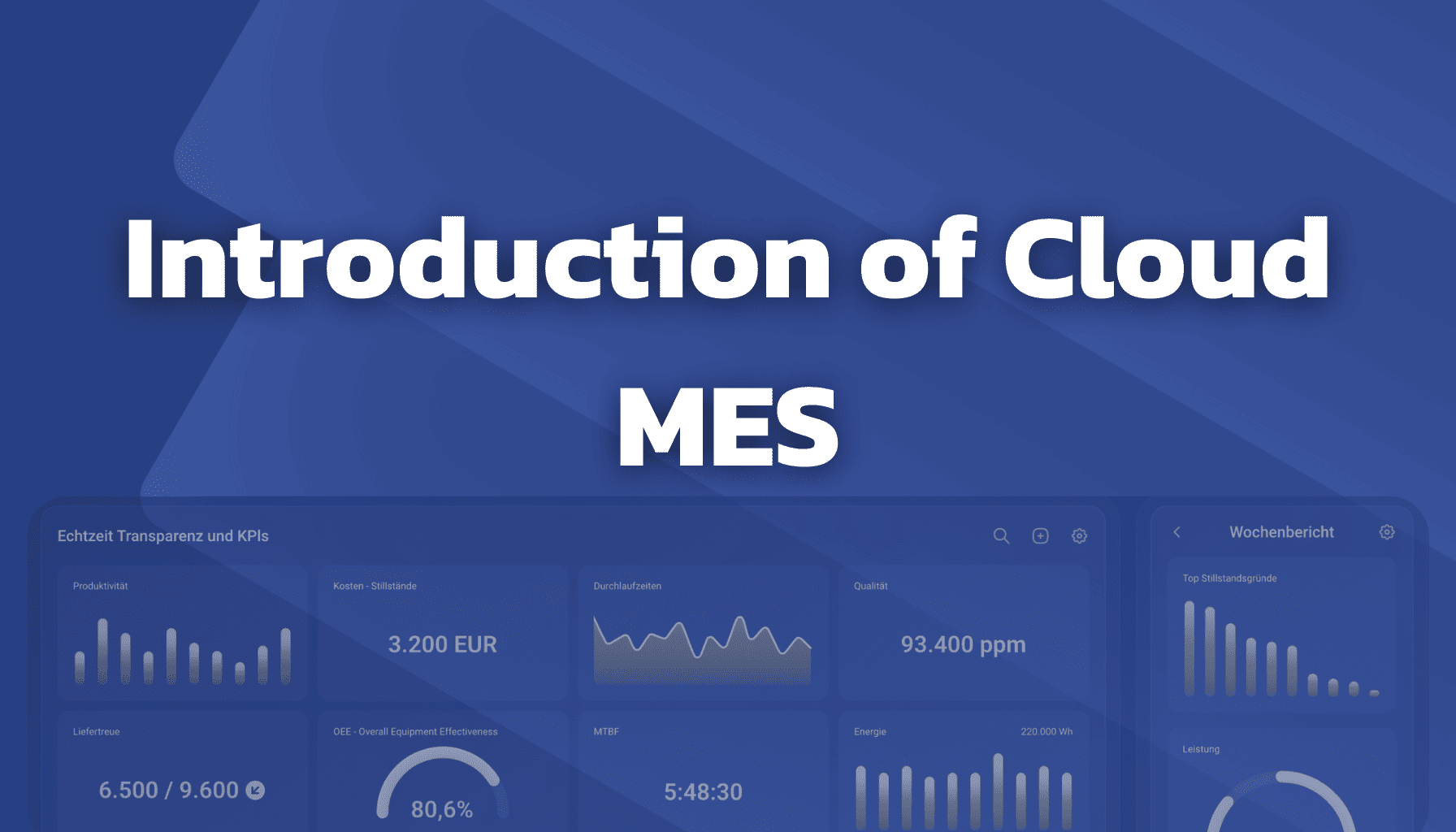Implementing Cloud MES - tips for a successful implementation

Why Cloud MES? The Benefits at a Glance
Before diving into the MES implementation roadmap, let’s explore the key benefits of a cloud-based MES compared to traditional on-premises solutions, revolutionizing digital manufacturing.
Deploy in weeks, not months or years, for an efficient Cloud MES implementation.
Minimal CAPEX costs with a SaaS model, perfect for cost-effective digital manufacturing.
Easily expand to additional lines, plants, or features with a cloud-native MES.
Continuous improvements without manual upgrades, ensuring up-to-date MES features.
Professional cloud infrastructure with cutting-edge security technology.
Access data and dashboards anywhere for flexible MES usage.
The 5-Phase Roadmap for Cloud MES Implementation
A successful Cloud MES implementation typically follows a structured process divided into five phases, driving efficient digital manufacturing.
Phase 1: Preparation & Requirements Analysis (1-3 Weeks)
This initial phase lays the foundation for the entire project’s success:
- Assemble the project team: Identify key stakeholders from production, IT, management, and shop floor.
- Conduct a current state analysis: Document existing processes, pain points, and improvement opportunities.
- Define objectives: Set clear, measurable goals for the MES implementation (e.g., 15% OEE increase).
- Prioritize processes: Identify critical processes to digitize first.
- Plan change management: Develop a strategy for employee engagement and training.
- Involve the works council early to avoid delays.
- Conduct workshops with diverse stakeholders to capture varied perspectives.
- Define KPIs to measure implementation success.
- Distinguish between "must-have" and "nice-to-have" requirements.
Phase 2: Piloting & Proof of Concept (2-4 Weeks)
The pilot phase tests the Cloud MES in a limited area to achieve quick wins:
- Select a pilot area: Choose a line or area with high optimization potential.
- Create a baseline configuration: Set up the system with core functionalities.
- Install IoT devices: Connect necessary gateways for data collection.
- Set up dashboards: Design relevant views for different user groups.
- Conduct initial training: Familiarize key users with the system.
- Choose a pilot area that’s representative but not critical to production.
- Focus on quickly achievable, high-value features (quick wins).
- Collect continuous user feedback and adjust the system accordingly.
- Document baseline metrics to demonstrate improvements later.
Phase 3: Customization & Optimization (2-4 Weeks)
After initial pilot experiences, customize the system to meet specific requirements:
- Optimize processes: Adjust workflows based on initial findings.
- Enable additional features: Expand the system with further required functionalities.
- Implement integrations: Connect the MES with other systems (ERP, QMS, etc.) as needed.
- Refine dashboards: Enhance visualizations based on user feedback.
- Set up alert mechanisms: Configure notifications for critical events.
- Keep customizations lean to minimize maintenance efforts.
- Leverage standard system functionalities wherever possible.
- Actively involve end-users in dashboard design.
- Document all configurations and customizations thoroughly.
Phase 4: Rollout & Scaling (2-8 Weeks)
Following a successful pilot, expand the system to additional areas:
- Create a rollout plan: Define the sequence for expanding to other areas.
- Build a system expert team: Train internal experts to support other areas.
- Deploy a training program: Conduct structured training for various user groups.
- Connect additional assets: Install extra IoT gateways and configure new assets.
- Transfer best practices: Apply insights from the pilot to other areas.
- Plan the rollout in phases, not as a "big bang."
- Identify change champions in each area to act as advocates.
- Standardize configuration and training processes.
- Celebrate and communicate successes to boost acceptance.
Phase 5: Continuous Improvement (Ongoing)
After successful implementation, focus on continuous optimization:
- Regular success reviews: Monitor defined KPIs and identify further optimization opportunities.
- Establish feedback loops: Continuously collect user suggestions for system improvements.
- Leverage new features: Regularly implement new functionalities available through updates.
- Integrate additional systems: Expand the integration landscape as needed.
- Deepen user knowledge: Provide advanced training for power users.
- Hold regular review meetings to share best practices.
- Utilize automatic updates of cloud-native solutions for continuous feature enhancements.
- Build a user community to foster knowledge exchange.
- Consider advanced analytics and AI capabilities for further optimizations.
The preparation phase is critical—thorough analysis ensures a smoother Cloud MES implementation. Cloud-native MES solutions like SYMESTIC enable rapid piloting. With pre-configured gateways communicating via mobile networks, data collection can start within hours, requiring no changes to existing IT infrastructure. This phase highlights the advantage of modular cloud platforms: features can be flexibly activated and combined without extensive coding.
SYMESTIC’s manufacturing platform offers specialized modules such as MDC (Machine Data Collection), ODC (Operational Data Collection), quality management, and energy monitoring, which can be activated as needed. The cloud-based architecture of modern MES solutions greatly simplifies scaling. With SYMESTIC, new assets can be connected simply by installing additional gateways, eliminating the need for complex infrastructure changes. A key benefit of Cloud MES solutions like SYMESTIC is continuous development: new features are automatically available without requiring costly upgrades.
Timeline: Realistic Schedule for Cloud MES Implementation
A key advantage of Cloud MES solutions is their significantly faster implementation compared to traditional on-premises systems. A realistic timeline for a mid-sized manufacturing company supports an efficient Cloud MES implementation, accelerating digital manufacturing.
Establish foundations, analyze requirements, and define objectives.
Test the system in a limited area to achieve quick wins.
Optimize the system based on pilot experiences.
Expand to additional areas, depending on the number of assets or sections.
Ongoing optimization for sustained efficiency gains.
The total duration from decision to full production deployment typically ranges from 7 to 19 weeks—significantly shorter than the 12-24 months common for traditional MES implementations. With SYMESTIC, it’s possible to capture and visualize real-time data within just three hours. This enables early successes and savings during the pilot phase, accelerating the Cloud MES implementation.
Start Your Cloud MES Journey Now
Experience the speed and efficiency of a cloud-native MES with SYMESTIC. Try our platform free for 30 days and see results in hours.
Try Free for 30 DaysCommon Challenges and Solutions
Implementing a Cloud MES often presents specific challenges. Here are the most common issues and proven solutions to ensure a seamless Cloud MES implementation in digital manufacturing.
1. Data Security Concerns
Challenge: Many companies are hesitant to store production data in the cloud.
Solution:
- Choose a provider with robust security certifications (ISO 27001, SOC 2, etc.).
- Ensure encrypted data transmission and storage.
- Verify the provider uses established cloud platforms like Microsoft Azure.
- Address data sovereignty and compliance questions upfront.
2. Integration of Legacy Machines
Challenge: Many production assets lack modern communication interfaces.
Solution:
- Use specialized IoT edge gateways to connect legacy machines.
- Implement digital signals for simple status monitoring.
- Consider additional sensors if needed.
- Combine automated and manual data collection methods.
3. Employee Resistance
Challenge: Changes often meet resistance, especially with concerns about monitoring.
Solution:
- Engage the works council early in the process.
- Clearly communicate benefits to employees (e.g., reduced workload, fewer errors).
- Provide comprehensive training sessions.
- Identify change champions to act as advocates.
- Showcase quick wins to boost acceptance.
4. Connectivity Issues
Challenge: Reliable network connections are critical for cloud-based systems.
Solution:
- Use redundant connection paths (e.g., LAN and mobile networks).
- Ensure edge computing capabilities for critical functions.
- Implement offline functionality for network outages.
- Verify network coverage across all production areas.
5. Data Consistency Issues
Challenge: Integration with existing systems can lead to data inconsistencies.
Solution:
- Define clear data ownership (which system is the "master" for specific data).
- Implement robust data mappings.
- Use standardized interfaces and formats.
- Schedule regular data quality checks.
SYMESTIC, built on the Microsoft Trusted Cloud, meets the highest security standards. Modern Cloud MES providers like SYMESTIC offer specialized edge gateways supporting various connection methods—from signal capture to OPC-UA and direct PLC integration. SYMESTIC’s edge gateways, which communicate via mobile networks, can buffer data during temporary connectivity disruptions, ensuring a smooth MES implementation.
Overcome MES Challenges Now
Kickstart your Cloud MES journey with SYMESTIC and tackle implementation challenges efficiently. Try our platform free for 30 days and benefit from proven MES solutions.
Try Free for 30 DaysSuccess Factors for Cloud MES Implementation
Based on insights from numerous successful implementations, the following success factors ensure a seamless Cloud MES implementation in digital manufacturing.
1. Management Commitment
The success of an MES project hinges on strong management support. Ensure:
- Clear objectives and success criteria.
- Adequate resource allocation.
- Active participation in project meetings.
- Decisive action on conflicting priorities.
2. Focus on User Acceptance
Even the best technology fails without user buy-in:
- Involve end-users early in the design process.
- Ensure intuitive, user-friendly interfaces.
- Provide comprehensive training and support.
- Communicate individual benefits to employees.
3. Phased Approach
“Think big, start small, scale fast” is the formula for MES success:
- Begin with a manageable pilot area.
- Focus on high-impact quick wins.
- Gather experience before scaling.
- Stay agile and adaptable.
4. Clear Responsibilities
An effective project team with defined roles is critical:
- Define clear responsibilities.
- Appoint a dedicated project leader.
- Establish an interdisciplinary team.
- Ensure sufficient resources and time budgets.
5. Continuous Success Measurement
You can’t improve what you don’t measure:
- Define clear, measurable KPIs.
- Capture baseline metrics before MES implementation.
- Track KPI progress regularly.
- Share successes across the organization.
Launch a Successful MES Implementation
Apply these success factors with SYMESTIC to kickstart your Cloud MES implementation. Try our platform free for 30 days and secure future-proof digital manufacturing.
Try Free for 30 Days


.png)
